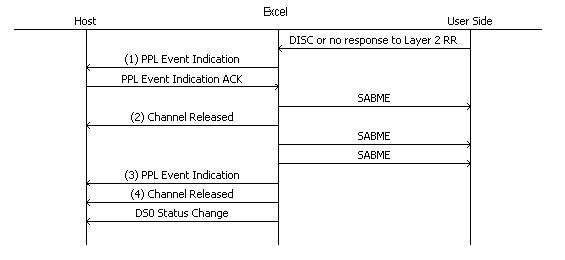
You are here: CSP Developer’s Guide: Common Channel Signaling > 8 ISDN > Network Side Euro-ISDN

Overview
The ISDN software module supports network side Euro-ISDN PRI variant. This allows CSPs to handle basic call control, interfacing with a user-side.
ETSI specification support
The following is supported as defined in the applicable ETSI specification:
• All procedures, messages, and message content defined as mandatory for network side functionality.
• All call states supported in Excel’s ISDN PRI user side implementation.
• All network side call setup and tear-down procedures.
• All mandatory, bidirectional (network-to-user and user-to-network), circuit mode connection control messages.
• All mandatory network-to-user messages.
• All information elements that are designated as mandatory for network-to-user side messages.
• All timer values.
• All network side error handling procedures.
Supported Q.931 Messages
The following Q.931 messages are supported:
Call establishment
• ALERTING
• CALL PROCEEDING
• CONNECT
• CONNECT ACKNOWLEDGE
• PROGRESS
• SETUP
• SETUP ACKNOWLEDGE
Call information phase messages
• USER INFORMATION
Call clearing messages
• DISCONNECT
• RELEASE
• RELEASE COMPLETE
Miscellaneous
• FACILITY
• INFORMATION
• NOTIFY
• STATUS
• STATUS ENQUIRY
Other
• REGISTER
Specification Compliance
The ISDN PRI network side implementation complies to the signals and signaling procedures described by the ETSI 300 102-1 and 300 102-2 specifications specific to network side, with the following exceptions:
Excel’s network side Euro-ISDN PRI implementation does not support the following:
• Call re-arrangement procedures (SUSPEND and RESUME) (ETSI 300 102-1 section 5.6)
• Message segmentation (ETSI 300 102-1 section 5)
• Sending the STATUS ENQUIRY message (ETSI 300 102-1 section 5.8.10)
• Sending the CONGESTION CONTROL message (ETSI 300 102-1 section 3.1.3)
• Sending the Keypad Facility Information Element
Configuration
The network side ISDN PRI configuration procedure is the same as for the user side except that you must configure the D Channel for Network Side using the ISDN Interface Configure 0x0060 message (see the API message formats in the API Reference).
Example Message
The following is an example of the ISDN Interface Configure message, which changes the Connection Type to network side Euro-ISDN.
Trace H->X FE 00 0F 00 60 00 00 01 00 01 0D 03 00 00 17 01 00 17
|
Byte |
Description |
Value and Indication |
|---|---|---|
|
0 |
0xFE |
|
|
1, 2 |
Length |
0x000F |
|
3, 4 |
Message Type |
0x0060 |
|
5 |
Reserved |
0x00 |
|
6 |
Sequence Number |
0x00 |
|
7 |
Logical Node ID |
0x01 |
|
8 |
AIB |
0x00 (Single Entity) |
|
9 |
Number of Address Elements |
0x01 |
|
10 |
Address Element Type |
0x0D (Channel) |
|
11 |
Data Length |
0x03 |
|
12, 13 |
Data[0,1] Logical Span ID |
0x0000 (Span 0) |
|
14 |
Data[2] Channel |
0x17 (Channel 23) |
|
15 |
Entity |
0x01 (Connection Type) |
|
16, 17 |
Data[0,1] Value |
0x0017 (Network Side Euro-ISDN) |
|
18 |
Checksum |
0xCS (not shown in trace) |
Call Flows
D Channel Failure with Re-establishment of D Channel
The following figure shows a call flow for a D channel failure followed by the re-establishment of the D channel.

1. Upon receiving a Layer 2 DISCONNECT, or no response to a Layer 2 RR (T203 expiry), from the User Side indicating a
D channel failure, the CSP sends a PPL Event Indication message of Network Side D Channel Temporary Malfunction (0x04).
2. All non-active calls are released and the host is sent Channel Released messages for each channel.
3. If the D channel is re-established within the period of the T309 timer (90 s), all active calls are maintained and the host is sent a PPL Event Indication message of Network Side D Channel
Re-established (0x06.)
D Channel Failure with no D channel Re-establishment
The following figure shows a call flow for a D channel failure with no re-establishment of the D channel.

1. On receiving a Layer 2 DISCONNECT, or no response to a Layer 2 RR (T203 expiry), from the user side indicating a D channel failure, the CSP sends a PPL event of Network Side D Channel Temporary Malfunction (0x04).
2. All non-active calls are released and the host is sent Channel Released messages for each channel.
3. If the D channel is not re-established within the T309 period
(90 s), the host is sent a PPL Event Indication message of Network Side D Channel Down (0x05).
4. All active calls are released and a Channel Released message is sent to the host for each channel, followed by:
• A DS0 Status Change message of Out of Service for all channels.